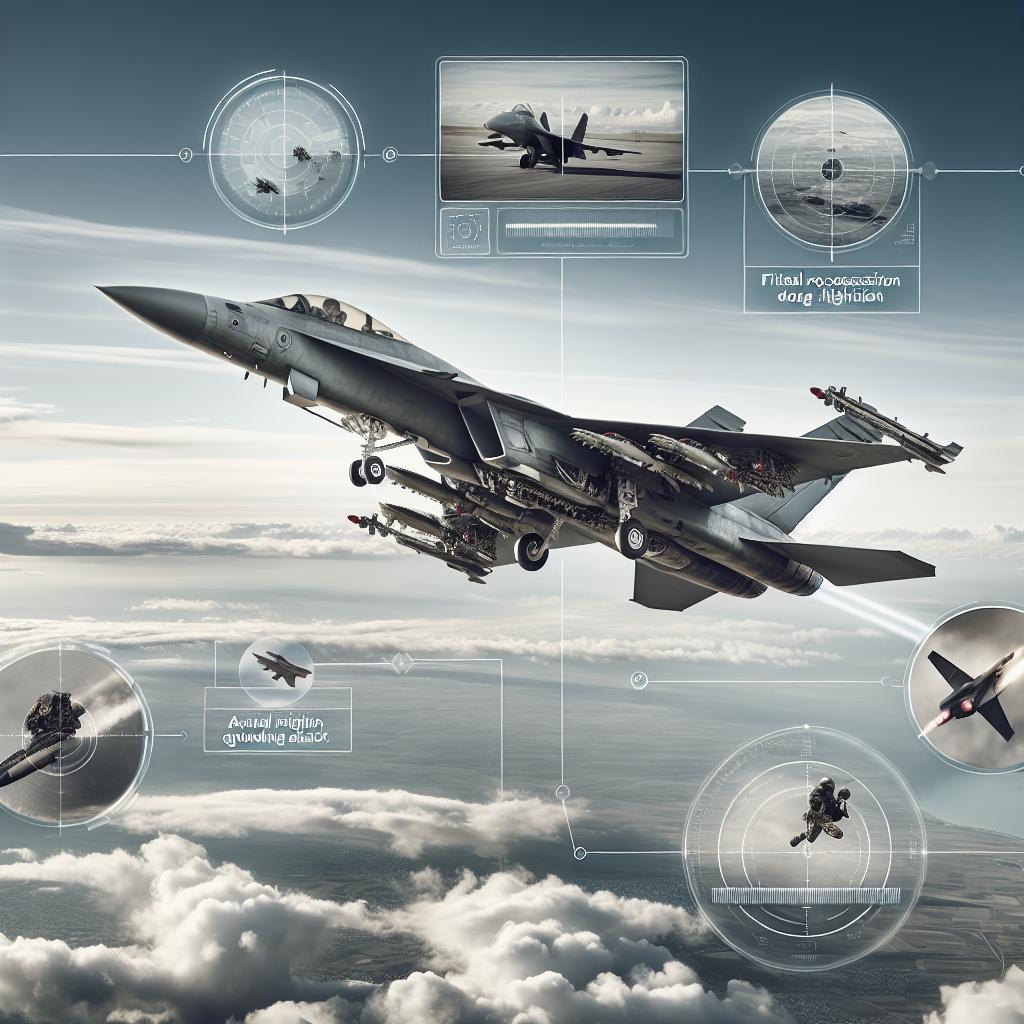“`markdown # Main Missions of a Fighter Jet
Introduction
In the complex theater of modern aerial warfare, fighter jets play an indispensable role, executing a wide range of critical missions. From maintaining air superiority to conducting ground attacks, reconnaissance, and electronic warfare, the versatility of fighter jets is essential for military success. Pilots and support teams must exhibit meticulous planning, flawless execution, and continuous learning to achieve mission objectives while adapting to dynamic combat environments. This blog delves into the main missions of fighter jets, breaking down the strategic and operational facets that enable these sophisticated aircraft to safeguard national security effectively.
Overview
Fighter jets are designed for several cornerstone missions that are crucial to military strategy and national defense. These missions not only require advanced technology but also depend on the skill and coordination of highly trained personnel. Their versatility allows them to adapt to varying combat situations, making them invaluable assets to modern air forces. From air superiority to ground attack, each mission category has specific objectives that align with broader military strategies. The variety of missions a fighter jet can undertake highlights its multifaceted role in contemporary warfare. Understanding these missions and their requirements provides insight into why significant investments are made in developing and maintaining fighter jet fleets. The following sections will explore these missions in detail, focusing on the elements that contribute to mission success.
Objective Clarity: The Key to Aligned Execution
Successful fighter jet missions start with crystal-clear objectives. Whether the goal is to establish air superiority, conduct a precision strike, or gather intelligence, all team members must understand the mission’s purpose and desired outcome. This clarity ensures that every action taken by the pilot and support crews is aligned with the overarching strategic goals. For example, in an air superiority mission, the primary objective might be to neutralize enemy aircraft to create a favorable airspace for ground operations. This objective guides the selection of weapons, tactics, and even the choice of aircraft deployed. On the ground, mission planners must communicate these aims clearly to ensure that intricate details like radar coverage and refueling schedules support the mission’s success.
Team Briefing: From Information to Ownership
Team briefings are crucial in transforming mission plans into actionable steps. During these sessions, detailed information about the mission is shared, such as intelligence on enemy forces, environmental conditions, and specific roles for each team member. Effective briefings turn information into ownership, where every individual fully understands and commits to their part in the mission. These sessions often include contingency plans and preset protocols for unexpected scenarios, ensuring that the team remains cohesive and responsive under pressure. Comprehensive briefings allow for questions and feedback, empowering each team member to perform optimally. In the high-stakes environment of aerial combat, such preparedness can make the difference between mission success and failure.
Resource Allocation: Beyond Budgets and Timelines
Resource allocation for fighter jet missions extends far beyond financial budgets and timelines. It encompasses the availability of aircraft, the quality of intelligence, trained personnel, and even logistical support such as fuel and armaments. Efficient allocation ensures that each mission component is adequately resourced to enhance operational effectiveness. For instance, a ground attack mission would require precise mapping of target areas, availability of specialized munitions, and coordination with ground forces for target verification. Similarly, reconnaissance missions depend on the availability of sophisticated sensors and real-time data processing capabilities. By considering these elements, military planners can allocate resources in a manner that maximizes mission success probabilities.
Strategic Roadmap: A Living, Breathing Document
A strategic roadmap for fighter jet missions is not a static document but a dynamic framework that evolves as new intelligence and situational changes emerge. This roadmap outlines multiple mission phases, from initial reconnaissance to final execution, incorporating contingency plans and alternative strategies. Updates to the roadmap might be necessary due to changing enemy tactics or unforeseen environmental conditions. Maintaining flexibility within the strategic roadmap allows mission planners to adapt quickly, ensuring continuous alignment with operational goals. In essence, a strategic roadmap provides a structured yet adaptable guide for executing complex missions.
Contingency Planning: Stress-Testing Your Strategies
Contingency planning is integral to fighter jet missions due to their inherently high-risk nature. Planners stress-test their strategies against various hypothetical scenarios to identify potential vulnerabilities and develop countermeasures. These may include alternative routes, backup communication systems, and secondary targets. Effective contingency planning involves rigorous training exercises that simulate scenarios like equipment failure, enemy ambushes, or adverse weather conditions. The aim is to ensure that both the pilots and support crews are prepared for any eventuality, thereby enhancing their ability to adapt and respond swiftly during real missions.
Market Reconnaissance: Data-Driven Insights
Market reconnaissance in military terms translates to intelligence gathering, where data-driven insights inform mission planning and execution. Reconnaissance missions employ advanced sensors and imaging technologies to collect critical information about enemy positions, movements, and capabilities. This data helps in creating accurate threat assessments and planning optimal mission routes. By leveraging real-time intelligence, fighter jets can perform targeted strikes with higher precision and lower risk. Accurate reconnaissance also aids in post-mission analysis, allowing military strategists to refine their approaches for future operations.
The Good Idea Cutoff Line: Transition from Planning to Action
The Good Idea Cutoff Line (GICL) signifies the transition point from planning to action. It’s a crucial moment when new suggestions are no longer accepted, ensuring the team focuses on executing the plan with maximum efficiency. After the GICL, the emphasis shifts to refining the existing plan rather than incorporating new ideas. This practice streamlines decision-making and reduces last-minute changes that could complicate the mission. In a dynamic and high-pressure environment, having a fixed cutoff ensures clarity and focus, enabling the team to execute the mission with confidence and precision.
Execution Phase: Monitor KPIs and Real-time Dashboards
During the execution phase, monitoring Key Performance Indicators (KPIs) and real-time dashboards becomes crucial. KPIs such as mission progress, fuel levels, and armament status provide valuable insights into the ongoing operation. Real-time dashboards allow command centers to track these metrics and make informed decisions quickly. For example, if a KPI indicates lower-than-expected fuel reserves, refueling operations can be initiated proactively. Similarly, real-time intelligence from sensors can prompt immediate adjustments to mission plans, ensuring optimal performance. These tools enhance situational awareness, allowing for real-time adaptations that contribute to mission success.
Post-Operational Debrief: Creating a Learning Organization
Post-operational debriefs are fundamental in fostering a learning organization within the military. After each mission, detailed reviews and analyses are conducted to identify successes, challenges, and areas for improvement. These debriefs involve all team members, encouraging open and honest feedback. Learnings from debriefs are documented and used to refine future mission strategies, update training programs, and enhance overall operational efficiency. By institutionalizing this feedback loop, military organizations can continually evolve and adapt, maintaining a high level of proficiency and readiness.
Summary
Fighter jet missions encompass a wide range of operations that require meticulous planning and execution. From defining clear objectives to conducting detailed team briefings, effective resource allocation, and strategic roadmapping, each step plays a crucial role in mission success. Contingency planning, data-driven reconnaissance, and clear transition points from planning to action further enhance mission effectiveness. Monitoring KPIs in real-time and conducting post-operational debriefs ensure continuous learning and improvement.
Trending Now
1. Advances in Fighter Jet Technology: Exploring the latest tech enhancements in modern fighter jets. 2. Pilot Training Programs: How new training methodologies are shaping the future of aerial combat. 3. AI in Military Ops: The growing role of artificial intelligence in mission planning and execution.
Final Thoughts
Here’s a summary of the main missions of a fighter jet, encapsulated in a table format for quick reference: “`html
| Mission Aspect | Description |
|---|---|
| Objective Clarity | Clear, specific goals ensuring mission alignment. |
| Team Briefing | Detailed mission plans shared, turning information into ownership. |
| Resource Allocation | Allocation of aircraft, intelligence, personnel, and logistics. |
| Strategic Roadmap | Dynamic document outlining mission phases and contingencies. |
| Contingency Planning | Stress-testing strategies against hypothetical scenarios. |
| Market Reconnaissance | Data-driven intelligence gathering for accurate threat assessments. |
| The Good Idea Cutoff Line | Transition from planning to action, reducing last-minute changes. |
| Execution Phase | Monitoring KPIs and real-time dashboards for informed decisions. |
| Post-Operational Debrief | Conducting reviews to identify improvements and enhance future operations. |
“` “`


